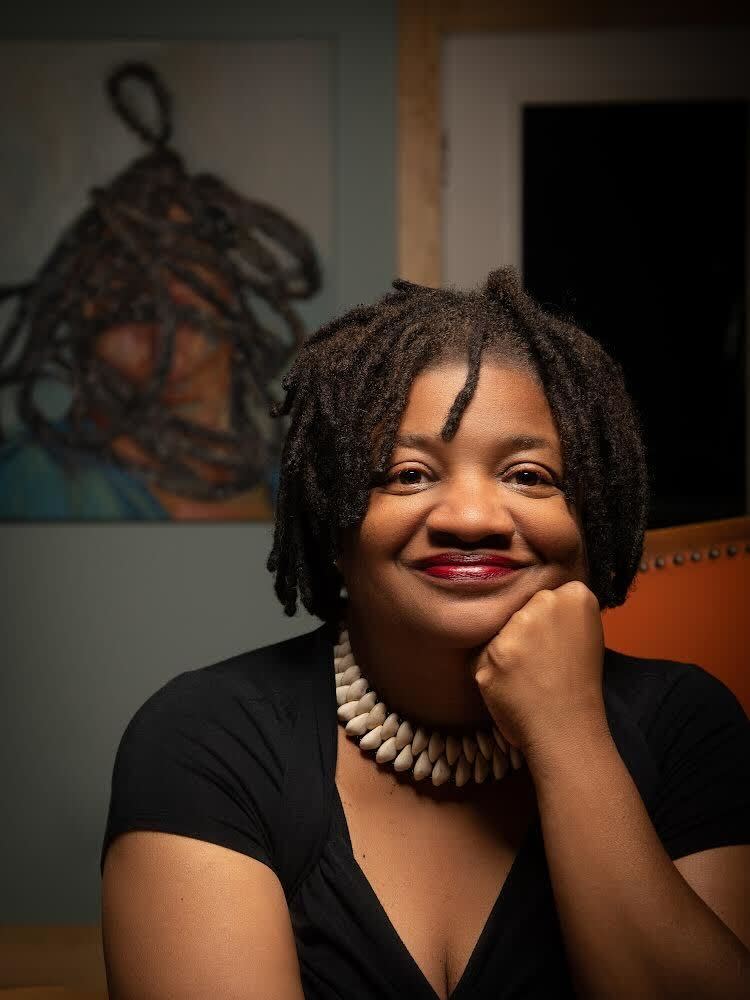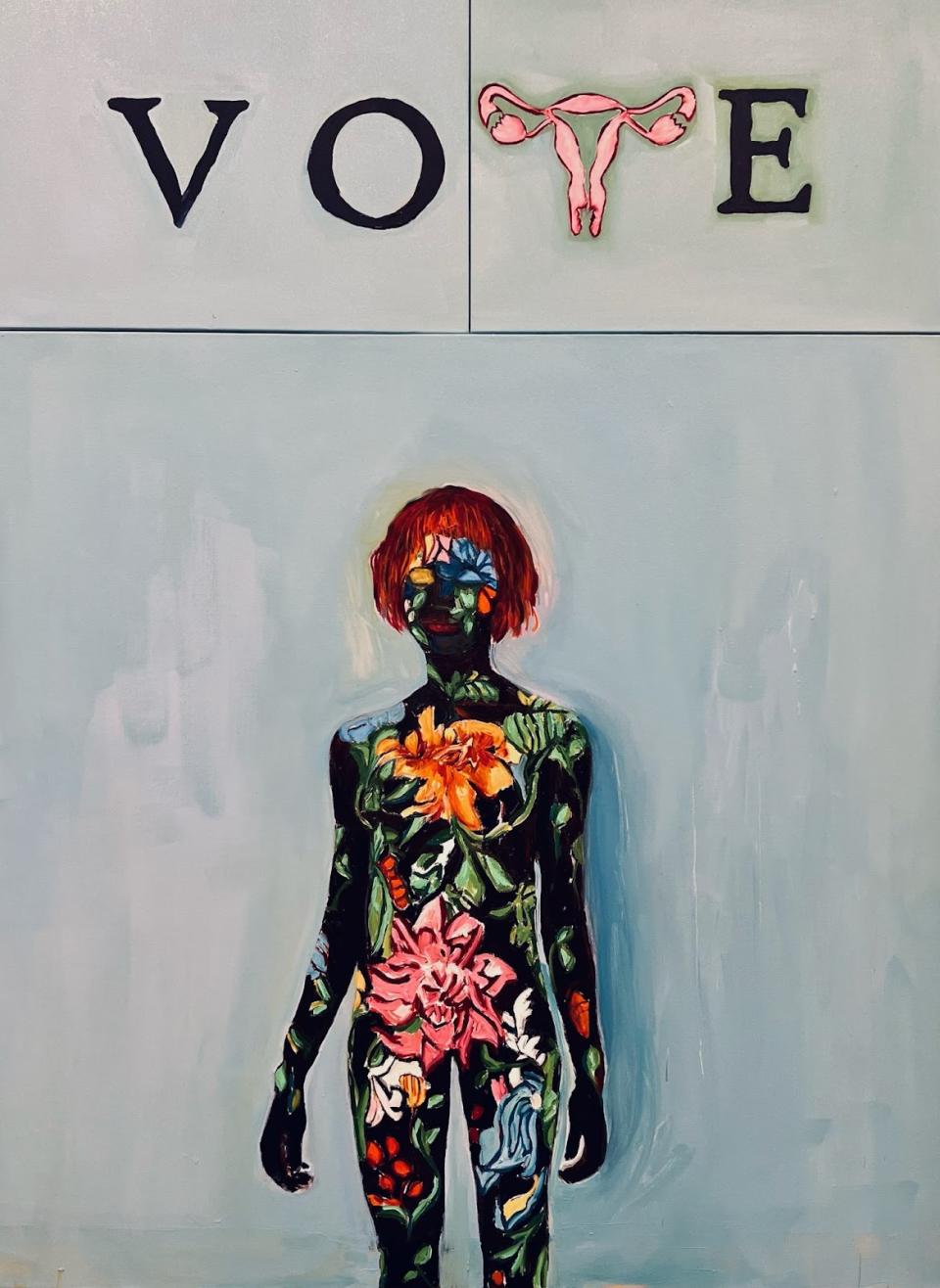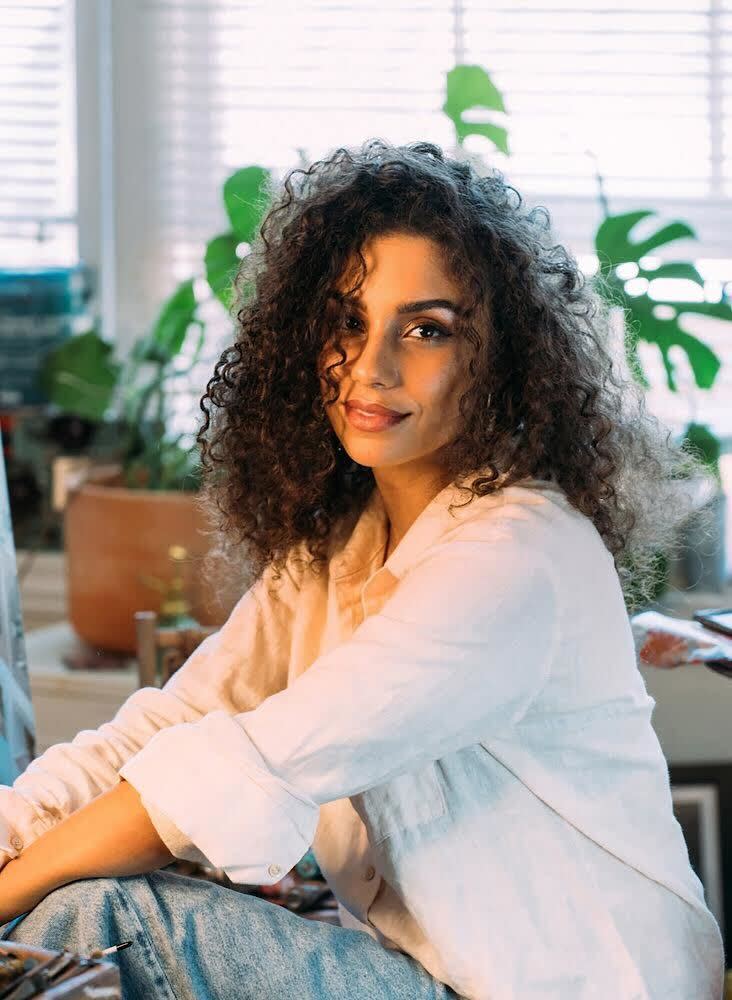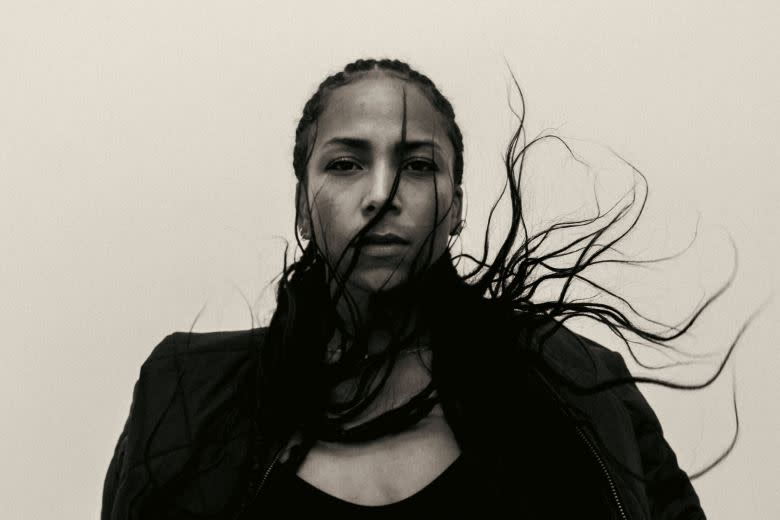Black Artists Respond to Increased Restrictions on Reproductive Rights
It took years for Beverly McIver to come back to the photo she snapped at the North Carolina Museum of Art. A woman had walked by completely naked, coated with black paint and outlines of flowers down her body. She was blending into the painting behind her. McIver, stunned in that moment, didn’t know that woman would be her muse, and that she’d paint her years later. She didn’t know a cry for reproductive justice would spill out of her and onto the canvas until it happened.
Suddenly, the figure of the woman she had seen filled the page along with the words, “VOTE” with a drawing of a uterus as a “T.” She called the painting, Black Beauty.

McIver, 61, is among a number of artists across the country who are using their creativity to craft messages about Black maternal health and reproductive health care. Through sculpture, they can voice more than words ever could, they say. Through self-portraits and collages, they say they’re illuminating truth. And, as abortion access becomes increasingly limited and the maternal mortality crisis persists, they feel an urgent call to move those who their art might touch into action as well as use the craft to fund medical efforts.
In more than a dozen states, abortion is banned in almost all circumstances, and 21 states have restricted abortion access sooner in pregnancy than was once the standard set by Roe v. Wade, which protected the right to an abortion up to the viability of the fetus. A number of states are still in the throes of courtroom battles to determine what the future of access to the procedure will look like.
McIver doesn’t have children, nor does the 63-year-old sister she cares for, who has had a hysterectomy and lives with a disability. Still, she feels strongly about supporting the next generation.
She grows hot with anger as she reflects on the overturning of Roe v. Wade. Through her art, she makes a statement, one that calls on those who see it to get out and vote as a means to protect their rights. As time passes, her modern work will integrate into a much more expansive history that fuses medicine, medical crises, and an artistic pull toward political action.
The first Black Beauty painting she made sold immediately. People loved it, she said. “It was a nice universal symbol that people wanted to live with.”


“Art helps us to imagine different ways of going forward,” said Anna Arabindan-Kesson, an associate professor of African American and Black Diasporic art at Princeton University. “This is a matter of life and death for many artists.” There’s an urgency to raise awareness and push people to change, she said.
In Los Angeles, two artists are partnering to make a statement about the recent restrictions on abortion access. Maya Guice, 33, picked up a camera a few years ago and has since turned to self-portraits. She’ll go into her studio, take some photographs, and then hand them to Victoria Cassinova for her to speak back to Guice’s work through collage and texture work.
“It’s this conversation between us both,” Cassinova said. They want to draw people to the polls and get them asking questions. They’re thinking about how they can get viewers to lean into the power they have as they begin to create a piece that builds off of one entitled My Choice, from 2022. Their latest piece is being made as a part of the People For the American Way’s Artists For Democracy campaign.

“The most impactful art leaves space for people to find themselves,” Guice said.
These pieces are markers of the movement. Stamps that preserve the emotions of the moment, freezing the angst, rage, and fear bubbling up to the surface. In time, the artists’ works will serve as an archive for future generations to look back on as they study the maternal mortality crisis and unwinding of abortion rights.
“Art has the power to shine light on truth,” said Cassinova, 30. It’s “about being courageous enough to say the thing that everyone is afraid to say.”
There’s power in “freedom of expression”
What’s happening today mirrors that of the AIDS crisis in the late 1980s and ’90s, which made way for new paintings, posters, murals, textiles and art forms that raised awareness and critiqued the government’s inaction. It also created a sense of community and brought folks together. The art emerged at a time when stigma around having the disease isolated many, and in 1994, it became the leading cause of death for all Americans ages 25 to 44. Photographers took portraits of their bodies and their loved ones’ bodies in order to document the development of the disease over time. Today, some of those pieces are considered fine art and are now testaments and memorials for the artists who’ve since passed.
Epidemic photography that documents disease and what’s done to control it has made ripples throughout history, from its first emergence in India during the bubonic plague to the coronavirus pandemic. The blend of art, medicine and advocacy have persisted across centuries.
In Camp Hill, Pennsylvania, near Harrisburg, Dr. Tonya Wright has merged her love of African diaspora art with her career as an OB-GYN. It’s only been recently, in the past year or so, that she has begun using art exhibitions to raise money for Black maternal health week events that bring together pregnant families and those looking to have a baby soon. The health events debunk myths and talk about how families can advocate for themselves through childbirth, to combat the high levels of severe health complications related to pregnancy.
For the exhibition, Wright and her husband asked artists to create works on the theme. Soon, many were reaching out to be a part of it. “They felt an urgent need to create work that told their personal stories,” she said. One artist has just suffered a traumatic birth experience and wanted to use this opportunity as therapy. Another created a piece called God Bless This Child made up of delivery blankets. Someone else made a piece crafted from hair clips, combs, and Black hair products.
The exhibitions help fund the public health work, geared toward arming patients and families with greater knowledge of how they might combat some of the systemic disparities that Black communities face. Wright’s family has hosted a number of exhibitions, including one raising money for leukemia and another to bring health care to those without access due to high costs.
There’s “a certain level of freedom of expression” with art, Wright said. The constraints that exist for the scholarly papers she works on, dictating the number of characters and lines, don’t exist with artwork, she said. It’s an opportunity to push the boundaries of expression and document what might otherwise be placed into boxes.
Arabindan-Kesson, the professor, agrees.
“It allows you to explore a whole range of ideas and experiences and feelings.”
The post Black Artists Respond to Increased Restrictions on Reproductive Rights appeared first on Capital B News.
